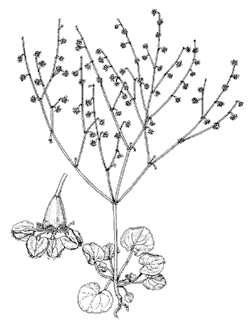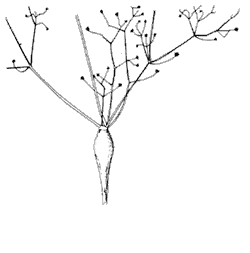Polygonaceae (buckwheat family)
The buckwheat family has 1200 species of trees, shrubs, herbs, and vines worldwide and is well represented in the Sonoran Desert. Buckwheat, rhubarb, and sorrel are edible members.
Eriogonum spp.
English names: skeleton weed
(many species), wild buckwheat
Spanish names: (vary with species)
 |
Description
Species in this genus vary in growth form from herbaceous annuals and perennials to woody shrubs. Most of the approximately 100 species in the Sonoran Desert region can be readily recognized by their general appearance. The herbaceous species are called skeleton weeds. Their basal rosettes of leaves are rather inconspicuous, but their inflorescences are distinctive. One to several of them arise from the basal rosette and branch profusely, often trifurcately, from a few inches to 2 feet (60 cm) tall. The flowering stems are leafless or nearly so, and bear tiny flowers at each node. Then they dry out and persist as skeletons for a year or more. Each of the 20 or so desert species has a distinct skeletal form, several of which are very attractive and are used in dried arrangements.
Range
The genus is distributed mainly in western North America. California is the center of distribution with more than 100 species.
Notes
The buckwheats have a wide variety of life histories. The most common of the skeleton weeds in our region is Eriogonum deflexum (flat-topped buckwheat); the skeletons are inverted, flat-topped cones that dry to a rusty-brown color. The seeds germinate in the fall with other winter annuals, but they don’t flower until summer. The most conspicuous species is E. inflatum (desert trumpet, guinagua). The flowering stems of this perennial grow to more than 3 feet (1 m) tall and are strongly swollen below each node. The swelling is caused by irritation from a moth larva that lives inside the hollow stem; the few stems not infested remain uninflated. The winter rains induce leaf production, and summer rain triggers flowering. The Seri drank a tea of desert trumpet as a cold remedy.
 |
The commonest shrubby buckwheat is Eriogonum fasciculatum (California buckwheat, maderista, valeriana). It is a densely branched, rounded shrub to about 2 feet (60 cm) tall and usually twice as wide, clothed with short, leathery, linear leaves. Many 1-inch (2.5 cm) clusters of tiny white flowers are supported above the foliage; they dry to a rusty brown and persist for several months. Eriogonum deserticola (desert buckwheat) is a long-lived woody shrub endemic to the sand sea of the Gran Desierto and the contiguous Algodones Dunes.
The few dozen species in the genus Chorizanthe are commonly called “spineflowers.” These herbs persist as dry skeletons like the skeleton weeds. They are smaller than most Eriogonum species, and most are prickly.










